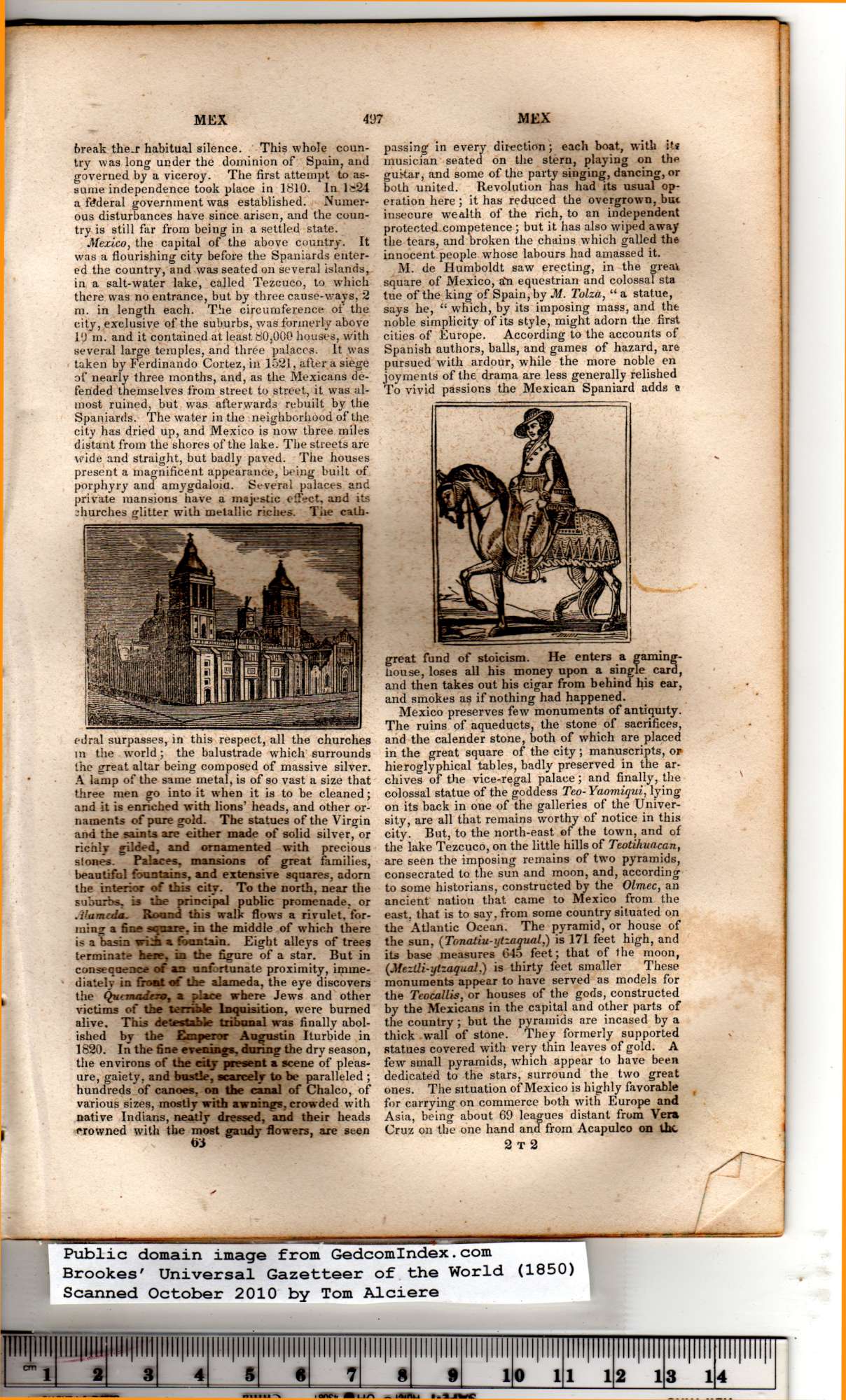|
break thejr habitual silence. This whole coun-
try was long under the dominion of Spain, and
governed by a viceroy. The first attempt to as-
sume independence took place in 1810. In lc24
a federal government was established. Numer-
ous disturbances have since arisen, and the coun-
try is still far from being in a settled state.
Mexico, the capital of the above country. It
was a flourishing city before the Spaniards enter-
ed the country, and was seated on several islands,
in a salt-water lake, called Tezcuco, to which
there was no entrance, but by three cause-ways, 2
m. in length each. The circumference of the
city, exclusive of the suburbs, was formerly above
10 m. and it contained at least, 80,000 houses, with
several large temples, and three palaces. It was
taken by Ferdinando Cortez, in 1521, after a siege
of nearly three months, and, as the Mexicans de-
fended themselves from street to street, it was al-
most ruined, but was afterwards rebuilt by the
Spaniards. The water in the neighborhood of the
city has dried up, and Mexico is now three miles
distant from the shores ofthe lake. The streets are
wide and straight, but badly paved. The houses
present a magnificent appearance, being built of
porphyry and amygdaloid. Several palaces and
private mansions have a majestic effect, and its
churches glitter with metallic riches. The cath-
edral surpasses, in this respect, all the churches
in the world; the balustrade which surrounds
the great altar being composed of massive silver.
A lamp of the same metal, is of so vast a size that
three men go into it when it is to be cleaned;
and it is enriched with lions’ heads, and other or-
naments of pure gold. The statues of the Virgin
and the saints are either made of solid silver, or
richly gilded, and ornamented with precious
slones. Palaces, mansions of great families,
beautiful fountains, and extensive squares, adorn
the interior of this city. To the north, near the
suburbs, is the principal public promenade, or
.iturn-:da. Round this walk flows a rivulet, for-
ming a fine square. in the middle of which there
is a basin wim a fountain. Eight alleys of trees
termimte here, in the figure of a star. But in
consequence ot an unfortunate proximity, imme-
diately in front ot" the alameda, the eye discovers
the Qu-madrro, a place where Jews and other
victims of the terrible Inquisition, were burned
alive. This detestable tribunal was finally abol-
ished by the Emperor Augustin Iturbide in
1820. In the fine evenings, during the dry season,
the environs of the city present a scene of pleas-
ure, gaiety, and bustle, scarcely to be paralleled ;
hundreds of canoes, on the canal of Chaleo, of
various sizes, mostly with awnings, crowded with
native Indians, neatly dressed, and their heads
crowned with the most gaudy flowers, are seen
passing in every direction; each boat, with its
musician seated on the stern, playing on the
guitar, and some of the party singing, dancing, or
both united. Revolution has had its usual op-
eration here ; it has reduced the overgrown, but
insecure wealth of the rich, to an independent
protected competence; but it has also wiped away
the tears, and broken the chains which galled the
innocent people whose labours had amassed it. |
M. de Humboldt saw erecting, in the great
square of Mexico, all equestrian and colossal sta
tue of the king of Spain, by M. Tolza, “ a statue,
says he, “ which, by its imposing mass, and the
noble simplicity of its style, might adorn the first
cities of Europe. According to the accounts of
Spanish authors, balls, and games of hazard, are
pursued with ardour, while the more noble en
joyments of the drama are less generally relished
To vivid passions the Mexican Spaniard adds a
great fund of stoicism. He enters a gaming-
house, loses all his money upon a single card,
and then takes out his cigar from behind his ear,
and smokes as if nothing had happened.
Mexico preserves few monuments of antiquity.
The ruins of aqueducts, the stone of sacrifices,
and the calender stone, both of which are placed
in the great square of the city; manuscripts, or
hieroglyphical tables, badly preserved in the ar-
chives of the vice-regal palace; and finally, the
colossal statue of the goddess Teo- Yaomiqui, lying
on its back in one of the galleries of the Univer-
sity, are all that remains worthy of notice in this
city. But, to the north-east of the town, and of
the lake Tezcuco, on the little hills of Teotihuncan,
are seen the imposing remains of two pyramids,
consecrated to the sun and moon, and, according
to some historians, constructed by the Olmec, an
ancient nation that came to Mexico from the
east, that is to say, from some country situated on
the Atlantic Ocean. The pyramid, or house of
the sun, (Tonatiu-ytzaqual) is 171 feet high, and
its base measures 645 feet; that of the moon,
(Meztli-ytzaqual.) is thirty feet smaller These
monuments appear to have served as models for
the Teocallis, or houses of the gods, constructed
by the Mexicans in the capital and other parts of
the country ; but the pyramids are incased by a
thick wall of stone. They formerly supported
statues covered with very thin leaves of gold. A
few small pyramids, which appear to have been
dedicated to the stars, surround the two great
ones. The situation of Mexico is highly favorable
for carrying on commerce both with Europe and
Asia, being about 69 leagues distant from Vera
Cruz on the one hand and from Acapulco on the
2 T 2 |
